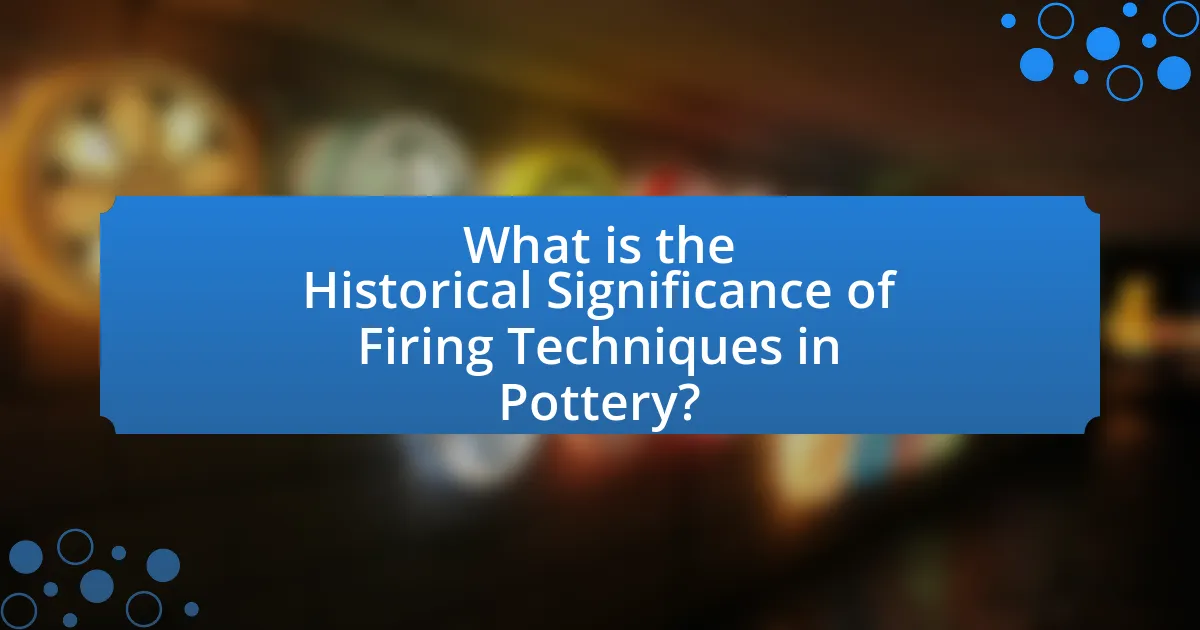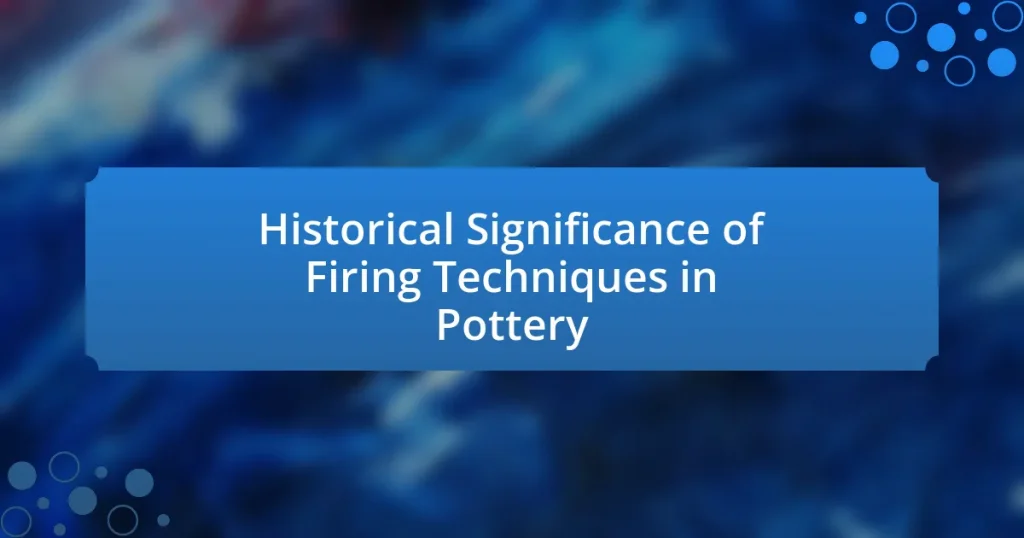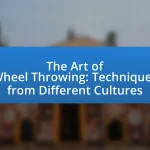The article examines the historical significance of firing techniques in pottery, highlighting their impact on the durability, functionality, and aesthetic qualities of ceramic artifacts. It traces the evolution of these techniques from primitive open fires to advanced kilns, illustrating how advancements in firing methods have influenced various pottery styles across cultures. Key topics include the earliest firing techniques, the role of cultural exchanges, the importance of firing in determining pottery properties, and the regional variations in firing practices. Additionally, the article discusses contemporary challenges and innovations in firing techniques, emphasizing their ongoing relevance in the field of pottery.

What is the Historical Significance of Firing Techniques in Pottery?
Firing techniques in pottery are historically significant because they determine the durability, functionality, and aesthetic qualities of ceramic artifacts. These techniques, which evolved from primitive open fires to advanced kilns, allowed for the development of various pottery styles and types across cultures. For instance, the introduction of high-temperature firing in ancient China led to the production of porcelain, which became a highly valued trade item. Additionally, the ability to control firing atmospheres enabled potters to create diverse glazes and surface finishes, influencing artistic expression and cultural identity. The historical progression of these techniques reflects technological advancements and the exchange of knowledge among civilizations, underscoring their importance in the evolution of human craftsmanship and cultural heritage.
How have firing techniques evolved throughout history?
Firing techniques in pottery have evolved significantly from ancient times to the present, transitioning from simple open fires to advanced kiln technologies. Initially, early potters used open fires to harden clay, which limited temperature control and resulted in uneven firing. As civilizations advanced, techniques improved; for example, the development of pit firing allowed for better heat retention and more consistent results.
By the time of the Han Dynasty in China (206 BCE – 220 CE), the introduction of kilns enabled potters to achieve higher temperatures and more refined finishes, leading to the creation of porcelain. The Industrial Revolution further transformed firing techniques with the invention of the bottle kiln and later, electric kilns, which provided precise temperature control and efficiency.
These advancements not only enhanced the quality and durability of pottery but also expanded artistic possibilities, as seen in the intricate glazes and designs that emerged in various cultures. The evolution of firing techniques reflects broader technological and cultural shifts throughout history, illustrating their critical role in the development of pottery as an art form.
What are the earliest known firing techniques used in pottery?
The earliest known firing techniques used in pottery include pit firing and open firing. Pit firing involves placing pottery in a pit filled with combustible materials, which are then ignited to create heat, while open firing occurs on the ground or in a bonfire setting. Archaeological evidence from sites such as Çatalhöyük in Turkey, dating back to around 7500 BCE, indicates that these methods were among the first utilized by ancient potters to harden clay objects. These techniques were crucial for the development of pottery, allowing for the creation of durable vessels essential for storage and cooking.
How did cultural exchanges influence firing techniques?
Cultural exchanges significantly influenced firing techniques in pottery by introducing diverse methods and materials that enhanced the quality and variety of ceramic products. For instance, the Silk Road facilitated the transfer of knowledge between East and West, leading to the adoption of high-temperature firing techniques from Chinese potters, which improved durability and aesthetics. Additionally, interactions among different cultures resulted in the blending of styles, such as the incorporation of glazes and decorative techniques from various regions, which enriched the artistic expression in pottery. Historical evidence shows that the introduction of stoneware in Europe was directly influenced by Asian pottery practices, demonstrating the tangible impact of cultural exchanges on firing techniques.
Why are firing techniques important in the context of pottery?
Firing techniques are crucial in pottery because they determine the final properties of ceramic objects, including strength, durability, and aesthetic qualities. The process of firing transforms raw clay into a hardened material through the application of heat, which causes chemical changes and physical transformations. For instance, high-temperature firing can lead to vitrification, where clay particles fuse together, resulting in a non-porous and robust ceramic. Historical evidence shows that different cultures developed unique firing techniques, such as pit firing, wood firing, and gas firing, each influencing the color, texture, and functionality of pottery. These techniques not only reflect technological advancements but also cultural practices and artistic expressions throughout history.
What role do firing techniques play in the durability of pottery?
Firing techniques are crucial for the durability of pottery as they determine the physical and chemical properties of the ceramic material. The temperature and atmosphere during firing influence the vitrification process, which enhances the strength and impermeability of the pottery. For instance, higher firing temperatures, typically above 1,000 degrees Celsius, lead to greater vitrification, resulting in a denser and more durable product. Historical evidence shows that ancient cultures, such as the Chinese during the Han Dynasty, utilized specific firing techniques to produce high-fired ceramics that have survived for centuries, demonstrating the long-term impact of these methods on pottery durability.
How do firing techniques affect the aesthetic qualities of pottery?
Firing techniques significantly influence the aesthetic qualities of pottery by affecting color, texture, and surface finish. Different firing methods, such as oxidation, reduction, and raku, produce distinct visual effects; for instance, oxidation firing typically results in bright, vibrant colors, while reduction firing can create deeper, more muted tones due to the chemical changes in the clay and glaze. Raku firing, characterized by rapid cooling and smoke exposure, often leads to unique crackle patterns and metallic sheens, enhancing the visual appeal. Historical evidence shows that ancient cultures, such as the Chinese and Native Americans, utilized specific firing techniques to achieve desired aesthetic outcomes, demonstrating the integral role of firing in the artistic expression of pottery.
What are the different types of firing techniques used in pottery?
The different types of firing techniques used in pottery include oxidation firing, reduction firing, raku firing, and pit firing. Oxidation firing occurs in an oxygen-rich environment, resulting in bright colors and stable glazes. Reduction firing, on the other hand, takes place in a low-oxygen atmosphere, which can create unique surface effects and colors due to the chemical changes in the clay and glaze. Raku firing is a rapid process where pottery is removed from the kiln while hot and placed in combustible materials, leading to distinctive crackle effects and metallic finishes. Lastly, pit firing is one of the oldest techniques, involving burying pottery in a pit with combustible materials, allowing for natural variations in color and texture. Each technique has historical significance, reflecting cultural practices and advancements in pottery throughout time.
What is the difference between oxidation and reduction firing?
Oxidation firing involves the presence of oxygen during the firing process, resulting in the complete combustion of materials and typically producing brighter colors in glazes and clays. In contrast, reduction firing occurs in an oxygen-restricted environment, leading to incomplete combustion, which can create darker, richer colors and unique surface effects due to the chemical changes in the materials. The difference is significant as it affects the final appearance and properties of the pottery, with oxidation firing generally yielding more vibrant hues and reduction firing allowing for more varied textures and tones.
How do traditional and modern firing techniques compare?
Traditional firing techniques, such as pit firing and wood firing, rely on natural materials and processes, while modern firing techniques, like electric and gas kilns, utilize controlled environments and advanced technology. Traditional methods often produce unique, unpredictable results due to variable temperatures and atmospheric conditions, whereas modern techniques allow for precise temperature control and consistency in outcomes. For example, traditional wood firing can reach high temperatures but is subject to the availability of wood and weather conditions, while electric kilns can maintain specific temperatures for extended periods, leading to uniformity in glaze and texture. This distinction highlights the evolution of pottery practices, reflecting advancements in technology and changes in artistic preferences.

What cultural impacts have firing techniques had on pottery?
Firing techniques have significantly influenced pottery by shaping cultural practices, artistic expression, and technological advancements. Different firing methods, such as pit firing, wood firing, and gas firing, have led to distinct aesthetic qualities and functional properties in pottery, reflecting the values and resources of various cultures. For instance, the use of reduction firing in Japanese ceramics has created unique glazes and surface textures that are integral to the cultural identity of Japanese pottery. Additionally, the development of kiln technology, such as the introduction of the noborigama kiln in Japan, has allowed for greater control over firing conditions, resulting in more complex and refined pottery styles. These advancements not only enhanced the artistic capabilities of potters but also facilitated trade and cultural exchange, as unique pottery styles became sought after across different regions.
How do firing techniques reflect the values of different societies?
Firing techniques in pottery reflect the values of different societies by showcasing their technological advancements, cultural practices, and aesthetic preferences. For instance, the use of high-temperature kilns in ancient Chinese pottery indicates a society that valued innovation and craftsmanship, leading to the production of durable and intricate ceramics. In contrast, the pit firing technique used by Indigenous cultures in the Americas emphasizes a connection to nature and communal practices, as it often involves the participation of the community in the firing process. Additionally, the decorative styles resulting from various firing techniques, such as the use of sgraffito in medieval European pottery, reveal societal values related to status and artistry. These examples illustrate how firing techniques serve as a lens through which the priorities and beliefs of different cultures can be understood.
What can pottery tell us about the technological advancements of a culture?
Pottery reveals significant insights into the technological advancements of a culture by showcasing their material knowledge, firing techniques, and artistic capabilities. The development of pottery techniques, such as the transition from hand-built to wheel-thrown pottery, indicates increased efficiency and skill in production methods. For example, the invention of the potter’s wheel around 3500 BCE in Mesopotamia allowed for more uniform shapes and faster production, reflecting advancements in both technology and craftsmanship. Additionally, the types of clay used and the firing temperatures achieved demonstrate a culture’s understanding of materials and their properties, as seen in the high-fired stoneware of ancient China, which required sophisticated kiln technology. These elements collectively illustrate how pottery serves as a tangible record of a culture’s technological evolution and innovation.
How have firing techniques been used in rituals or ceremonies?
Firing techniques have been integral to rituals and ceremonies, particularly in the context of pottery, where they symbolize transformation and the connection between the physical and spiritual realms. In many ancient cultures, such as the Japanese and Native American societies, the firing process was often accompanied by specific rituals intended to invoke spiritual protection or blessings on the finished pottery. For instance, in Japanese Raku pottery, the firing technique involves removing pieces from the kiln while still hot and placing them in combustible materials, a practice that is often performed during tea ceremonies to enhance the spiritual experience. Additionally, archaeological evidence indicates that ancient civilizations, like the Moche in Peru, used elaborate firing techniques in ceremonial pottery to reflect their cosmological beliefs, often incorporating symbolic designs that were believed to connect the material world with the divine.
What are the regional variations in firing techniques?
Regional variations in firing techniques in pottery include methods such as pit firing, wood firing, and gas firing, each reflecting local resources and cultural practices. For instance, pit firing, commonly used in indigenous cultures, involves burying pottery in a pit with combustible materials, resulting in unique surface effects. In contrast, wood firing, prevalent in East Asian traditions, utilizes a wood-fueled kiln, producing distinctive ash glazes and textures. Gas firing, often found in contemporary Western pottery, allows for precise temperature control and consistent results. These techniques demonstrate how geography, available materials, and cultural heritage shape pottery practices across different regions.
How do firing techniques differ between Eastern and Western pottery traditions?
Firing techniques in Eastern and Western pottery traditions differ primarily in their methods and temperatures used. Eastern pottery, particularly in regions like China and Japan, often employs high-temperature kilns, such as the dragon kiln, which can reach temperatures above 1,300 degrees Celsius, allowing for the creation of durable stoneware and porcelain. In contrast, Western pottery has historically utilized lower-temperature firing techniques, such as earthenware and stoneware kilns, typically firing between 1,000 to 1,200 degrees Celsius, resulting in different textures and finishes. This distinction is evident in the types of glazes and surface treatments used, with Eastern traditions favoring intricate glazing techniques that enhance aesthetics, while Western traditions often emphasize functional forms and simpler glazes.
What unique firing methods are found in indigenous pottery practices?
Indigenous pottery practices feature unique firing methods such as pit firing, open firing, and wood firing. Pit firing involves placing pottery in a pit filled with combustible materials, which creates variable temperatures and unique surface effects. Open firing occurs on the ground, allowing for direct exposure to flames and smoke, resulting in distinctive colorations and textures. Wood firing utilizes a kiln where wood is the primary fuel source, producing high temperatures that enhance the durability and aesthetic qualities of the pottery. These methods are historically significant as they reflect the cultural practices and environmental adaptations of various indigenous communities, showcasing their deep connection to the land and resources available to them.

How do firing techniques influence contemporary pottery practices?
Firing techniques significantly influence contemporary pottery practices by determining the final appearance, durability, and functionality of ceramic pieces. Different firing methods, such as oxidation, reduction, and raku, affect the color, texture, and surface quality of the pottery. For instance, oxidation firing typically results in brighter colors, while reduction firing can produce more muted tones and unique surface effects due to the interaction of glazes with the atmosphere inside the kiln. Additionally, contemporary potters often experiment with traditional techniques, such as wood firing, to create distinctive finishes and enhance the aesthetic appeal of their work. This blending of historical methods with modern practices showcases the ongoing evolution of pottery and highlights the importance of firing techniques in shaping artistic expression and craftsmanship in the field.
What modern innovations have emerged in firing techniques?
Modern innovations in firing techniques for pottery include the use of electric kilns, gas kilns with programmable controls, and alternative firing methods such as Raku and pit firing. Electric kilns allow for precise temperature control and consistent results, enhancing the quality of the final product. Gas kilns, equipped with digital controllers, enable potters to achieve specific atmospheres during firing, which can influence the color and texture of the glaze. Additionally, alternative firing methods have gained popularity for their unique aesthetic outcomes, allowing artists to experiment with traditional techniques in contemporary contexts. These advancements reflect a blend of technology and artistry, significantly impacting the pottery-making process.
How has technology changed the way pottery is fired today?
Technology has significantly transformed pottery firing methods today by introducing electric kilns and advanced temperature control systems. Electric kilns allow for more precise temperature regulation, enabling potters to achieve consistent results and reduce the risk of defects. Additionally, advancements in kiln design, such as the use of computer-controlled firing schedules, enhance efficiency and energy use, allowing for faster firing times and reduced fuel consumption. These innovations have led to improved quality in pottery production and expanded the range of techniques available to artisans, as evidenced by the widespread adoption of these technologies in contemporary pottery studios.
What are the environmental impacts of contemporary firing techniques?
Contemporary firing techniques in pottery have significant environmental impacts, primarily due to energy consumption and emissions. These techniques often rely on fossil fuels, which contribute to greenhouse gas emissions, thereby exacerbating climate change. For instance, traditional kilns can emit substantial amounts of carbon dioxide and other pollutants, affecting air quality and contributing to global warming. Additionally, the extraction of raw materials for pottery production can lead to habitat destruction and soil degradation. Studies indicate that transitioning to more sustainable firing methods, such as electric kilns or alternative fuels, can mitigate these negative effects by reducing emissions and energy use.
What challenges do potters face with firing techniques today?
Potters today face several challenges with firing techniques, primarily related to temperature control, fuel availability, and environmental regulations. Temperature control is critical, as achieving the precise heat required for different clay bodies and glazes can be difficult, leading to inconsistent results. Additionally, the availability of traditional fuels, such as wood, is declining due to environmental concerns and regulations, pushing potters to adapt to alternative energy sources that may not provide the same results. Furthermore, stricter environmental regulations on emissions from kilns complicate the firing process, requiring potters to invest in more advanced technology or modify their techniques to comply with these standards.
How can potters troubleshoot common issues in firing?
Potters can troubleshoot common issues in firing by closely monitoring temperature, kiln atmosphere, and the materials used. For instance, if pottery is underfired, it may remain porous and weak; potters can address this by increasing the firing temperature or extending the firing time. If pieces are overfired, resulting in warping or melting, reducing the temperature or adjusting the kiln’s ventilation can help. Additionally, issues like uneven glaze application can be resolved by ensuring consistent thickness and proper application techniques. Historical records indicate that ancient potters often experimented with firing conditions to achieve desired results, demonstrating the importance of careful observation and adjustment in the firing process.
What best practices can enhance the effectiveness of firing techniques?
Best practices that can enhance the effectiveness of firing techniques in pottery include maintaining consistent temperature control, using appropriate kiln atmospheres, and selecting suitable materials. Consistent temperature control ensures even heat distribution, which is crucial for achieving desired glaze effects and structural integrity. Research indicates that fluctuations in temperature can lead to defects such as cracking or uneven glazing. The use of specific kiln atmospheres, such as oxidation or reduction, can significantly impact the final appearance and properties of the pottery. For instance, reduction atmospheres can enhance certain glaze colors, as documented in studies on ceramic firing methods. Additionally, selecting high-quality clay and glaze materials tailored to the firing technique can improve the overall outcome, as evidenced by historical practices in various cultures that optimized local resources for firing.


